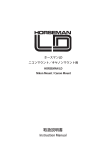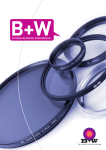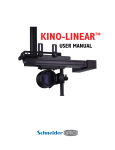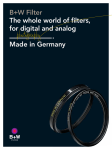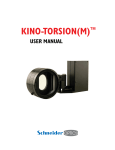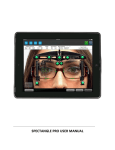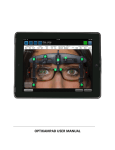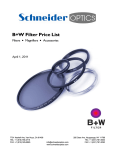Download Schneider Optics f/2.8 User's Manual
Transcript
PC-SUPER-ANGULON 28 mm f/2.8 User Manual Schneider Optics Inc. 285 Oser Avenue Hauppauge · NY ¡¡788 · USA Phone 63¡.76¡.5000 Fax 63¡.76¡.5090 [email protected] www.schneideroptics.com Exclusive distributor for the USA List of Contents Name of Parts and Cross Section of the Lens . . . . . . . . . . . . . . . . . . . . . . . . . . . . . . . . . . 3 General Description . . . . . . . . . . . . . . . . . . . . . . . . . . . . . . . . . . . . . . . . . . . . . . . . . . . . . . . . . . . . . . . . . 4 Perspective Correction for Analog and Digital Photos . . . . . . . . . . . . . . . . . . 6 Large Image Circle for Lens Shifts up to ¡¡ mm . . . . . . . . . . . . . . . . . . . . . . . . . . . . . . . . . 8 Fixing and Removing the Lens . . . . . . . . . . . . . . . . . . . . . . . . . . . . . . . . . . . . . . . . . . . . . . . . . . . . ¡0 Replacing the Mount for a Different Camera . . . . . . . . . . . . . . . . . . . . . . . . . . . . . . . . . . . ¡0 Parallel Shift . . . . . . . . . . . . . . . . . . . . . . . . . . . . . . . . . . . . . . . . . . . . . . . . . . . . . . . . . . . . . . . . . . . . . . . . . . ¡1 Focusing and Depth of Field . . . . . . . . . . . . . . . . . . . . . . . . . . . . . . . . . . . . . . . . . . . . . . . . . . . . . . ¡2 Measuring the Exposure . . . . . . . . . . . . . . . . . . . . . . . . . . . . . . . . . . . . . . . . . . . . . . . . . . . . . . . . . . . ¡3 Filters, Lens Hood and Camera Mounts . . . . . . . . . . . . . . . . . . . . . . . . . . . . . . . . . . . . . . . . ¡4 Specifications . . . . . . . . . . . . . . . . . . . . . . . . . . . . . . . . . . . . . . . . . . . . . . . . . . . . . . . . . . . . . . . . . . . . . . . . ¡6 Shape, appearance and specifications are subject to change without notice. Name of Parts and Cross Section of the Lens Focusing ring PC-SUPER-ANGULON Distance scale Depth of field scale Aperture scale Aperture setting ring 1 1,25 1,5 2 3 5 0,3 0,35 0,4 0,5 0,7 1 3 22 16 8 4 2,8 4 5,6 8 Pre-set aperture setting lever Shifting knob Index Knurled ring Camera mount Fixing screw for camera mount General Description The SCHNEIDER PC-SUPER-ANGULON 28 mm f/2.8 is a very high-quality wide-angle lens for 35 mm analog and digital SLR cameras and provides a parallel shift facility like the sliding lens panel of professional large-format cameras for correcting converging vertical lines and for manipulating the perspective especially for use in architectural and product photography. Whereas normal 35 mm lenses have an image circle diameter of around 44 mm so that all four corners of the image are inside the image circle, the PC-SUPER-ANGULON 28 mm f/2.8 provides an incredible 62 mm image circle. Decentration up to ¡1 mm is possible within this area using a dovetail guide which can be adjusted easily and exactly. The rotatable mount allows any desired shift direction. Not shifted m 22 16 8 4 4 8 16 22 2,8 4 5,6 8 11 16 22 1,25 1,5 2 3 5 oo 0,35 0,4 0,5 0,7 1 3 m 22 16 8 4 4 8 16 22 2,8 4 5,6 8 11 16 22 1,25 1,5 2 3 5 oo 0,35 0,4 0,5 0,7 1 3 Maximally shifted Vertical shift is the most popular: upward, especially when photographing high buildings, so that the camera does not have to be tilted upward; and downward for product shots at an oblique angle or also for shots from high locations such as towers or mountains so that the camera does not have to be tilted downward. When the camera is tilted either upward or downward, perpendicular lines are not imaged as perpendicular, but rather converge upward or downward, which is very pronounced in wide-angle shorts and can be very irritating. These converging lines can be prevented with the PC-SUPER-ANGULON 28 mm f/2.8 just as with adjustable large-format cameras. If the adjustment range of ¡1 mm (the clearance of the camera bayonet fixes this limit) is not sufficient in extreme cases due to the oblique view being too steep, the parallel shift of the lens largely prevents the sloped position of the converging lines and furthermore also reduces the vertical compression of the imaged object which would otherwise occur. The image then again corresponds to the natural visual impression. The rotary mount, however, also allows horizontal movements or a shift in a slanted direction, e. g. to be able to take a frontal photograph without any distortion from a lateral location or a location with a slanted offset if this would otherwise be impossible due to an obstacle or potential reflections. Perspective Correction for Analog and Digital Photography The equalizing of converging lines or of unfavorable perspective due to a camera location made necessary by obstacles, reflections or danger, e.g. traffic, is not only interesting for conventional analog photography, but also for digital photography when higher quality demands are made. While digital images or digitized (scanned) analog images can be equalized on the computer using image editing software such as Photoshop, this is, however, associated with substantial degrading: If the rectangular image is distorted in the manner of a trapezoid for the parallel alignment of the converging lines, the interpolation (recalculation of the pixels) required for this reducBuilding is true to scale but cropped on top Building not true to scale, vertically compressed Converging lines Horizon Horizon Too much foreground oo m 3 5 3 2 1 16 22 1,25 1,50,5 0,7 4 48 22 22 16 8 0,35 0,4 11 16 5,6 8 2,8 4 m 22 16 8 4 4 8 16 22 2,8 4 5,6 8 11 16 22 1,25 1,5 2 3 5 oo 0,35 0,4 0,5 0,7 1 3 Optical axis al axis Optic ≈ ¡3° es the sharpness, produces just visible bluish violet or reddish brown color fringes at edges which have been made perpendicular under fairly high enlargement and gives an image with incorrect proportions (width-to-height ratio). Since the final image must, however, be rectangular, the triangular areas projecting on two sides have to be cut off, which shows how many pixels, which are important for high resolution, are lost. At the same time, the surroundings almost always become very small at the narrow side of the trapezoid or the actual motif is even cropped. The optical equalization actually during the shot with the PC-SUPER-Angulon 28 mm f/2.8 avoids this. Too low Building is true to scale and completely reproduced Too wide Vertical lines are parallel Horizon Vertical shift of 7 mm m 22 16 8 4 4 8 16 22 2,8 4 5,6 8 11 16 22 1,25 1,5 2 3 5 oo 3 0,35 0,4 0,5 0,7 1 Optical axis Large Image Circle for Lens Shifts up to 1¡ mm The PC-SUPER-ANGULON 28 mm f/2.8 already produces an exceptionally flattened image at full aperture within the 62 mm image circle which is thus twice as large in area relative to the image circles of other 35 mm lenses. Sharpness and contrast are increased further in the central area used without shift by stepping down slightly to f/4 to f/5.6. Sharpness, contrast and brightness naturally drop outside this area due to the huge image angle with an open aperture. The full aperture with a decentered lens is therefore only intended for the image composition and the focusing. A good imaging performance is obtained at the edge when stepping down further in dependence on the adjustment path; an aperture of ¡1 is recommended at maximum shift. Distortion and vignetting are exceptionally low. While the image quality falls considerably in the close range with many wide-angle lenses, the good imaging properties of this lens are maintained thanks to “floating elements” (a distance-coupled axial shift of a lens element group relative to the remaining system). This makes this lens very interesting e. g. for model shots. The adjustment takes place at a shifting knob on a flexible shaft which is easy to grip and sensitive in operation. Millimeter scales on mutually opposite sides allow comfortable reading in any shifting knob position. Since the shift is possible at both sides of the zero position, the most favorable ori- entation can always be chosen, e. g. irrespective of the shift direction with the knob at the bottom with free hands, or rather at the top at the tripod. With a shift to the left or to the right, the shifting knob can always be at the left so that the right hand can hold the camera and remain on the release button. Natural size max. ¡¡ mm max. ¡0.5 mm max. 9.5 mm Imag e circle 44 mm Image c ircle 62 mm With a diagonal shift, the adjustment path should not go beyond the lock noticeable at 9.5 mm to prevent vignetting. ¡0 Fixing and Removing the Lens The lens is available in a connection socket to match different 35 mm SLR camera systems and is inserted into the camera bayonet or thread for fastening to the camera such that the red dot on the connection socket is opposite the corresponding marking on the camera. To lock the lens in the bayonet or thread and to release it again, the lens should be rotated at the knurled ring and not at the tube since the latter is not rigidly connected to the bayonet or thread due to the rotary mount and since there is therefore a risk that the tube will turn without the bayonet or thread engaging and tightening up to the stop. Replacing the Mount for a Different Camera The camera mount of the lens is fastened using Phillips screws and can be replaced to match the new camera on a change of the camera system. The user can make the refitting him or herself using a size zero Phillips screwdriver. The table on page ¡5 shows the camera systems for which camera mounts can be obtained and gives their order numbers. Parallel Shift The lens is shifted perpendicular to the optical axis relative to the bayonet mount and so also relative to the taking format by rotating a knurled shifting knob at a shaft which is elastically flexible to protect against its damage or injury to the user. The lens tube can be rotated continuously to the left or the right in a rotary mount so that the parallel shift can be made in any desired direction. It is best to grip the lens at the flattened part with the millimeter scales for this purpose. 45° latch steps ensure a precise vertical or horizontal parallel shift as required. The maximum path of ¡1 mm at both sides can be utilized to the full in the shift direction of the short image edge (vertical in landscape format and horizontal in portrait format) if the camera is stopped down to at least f/8. On a shift in the direction of the long image edge (horizontally in landscape and perpendicular in portrait), low vignetting of the image corners opposite to the shift (= of objects on the same side of the shift because of the upside-down image) may occur over the last half millimeter. It is therefore recommended only to utilize the shift path up to 10.5 mm here and to stop down to f/¡1 with more than 9 mm to avoid this vignetting in critical motifs. The noticeable latch step at 9.5 mm should not be exceeded diagonally even at f/¡1 with parallel shifts since then the image corner decentered the most will contact the image circle edge (see image on page 9). ¡1 ¡2 Focusing and Depth of Field The focusing of wide-angle lenses appears to be relatively non-critical due to their large depth of field. However, careful focusing is actually necessary to utilize the high imaging quality of this lens to the full. To ensure maximum brightness of the focusing screen and the best recognition of the ideal focusing point, the aperture should be opened by pivoting the stoppingdown lever toward the shifting knob. The aperture setting ring therefore remains on the set working aperture so that the aperture can later again be closed to the working aperture quickly using the stopping-down lever directly before the shot without moving the eye from the viewfinder. Focusing can generally take place before or after the parallel shift as desired. However, if the LED focus display of an autofocus camera is used for manually focusing, focusing must take place in the centered position (i. e. with a non-shifted lens) because the AF sensor requires incidence of light approximately parallel to the axis, but the light is obliquely incident on the sensor when the lens is shifted. The parallel shift which then takes place after the focusing does not influence the set distance. The f-numbers at both sides of the index mark for distance and aperture indicate the depth of field: If e. g. everything from ¡ m to 3 m should be sharp, the distance ring should be set so that the meter figures ¡ and 3 are above the same f-number (here: 8) at both sides of the index mark. Measuring the Exposure If the measurement is not carried out using a separate hand exposure meter, but using the TTL exposure meter integrated in the camera, it is necessary to measure in the centered position of the parallel shift while stopping down to the working aperture because the arrangement and alignment of the measuring cell of almost all SLR cameras requires a direction of light incidence axially symmetrically to the lens bayonet. With an oblique incidence through the lens displaced from the center, some of the light bundle can be shadowed so that then less light is incident onto the measuring cell. A higher exposure would therefore be displayed or set with an automatic exposure system so that overexposure would result. If the exposure is measured with a non-shifted lens, the camera must equally be aligned with the motif as if the motif would later also thus be photographed with a non-shifted lens. The darkening of the image visible in the viewfinder with a lens shifted a large distance does not carry over to the image and so also does not require any correction of the exposure. This is due to a larger light fall-off at the open aperture and due to the viewfinder system being aligned to an exactly centered lens and not being adjustable to the shifted lens as well as to the mirror not going down far enough for the low position of the lens in the event of a downward shift. No vignetting occurs at the actual taking. ¡3 ¡4 Filters, Lens Hood and Camera Mounts Only the oversized B+W WA filters of the size 67 EW can be used with the SCHNEIDER PC-SUPER-ANGULON 28 mm f/2.8 due to the extremely large image angle utilized at maximum shift up to 93.4°. The following table shows the order numbers of the most popular filter types – further types are available. The two B+W polarization filters shown there (linear and circular) have a special rotary mount and are dimensioned such that they do not produce vignetting even at maximum parallel shift of the lens. An additional lens hood can, however, unfortunately not be used in combination with these polarization filters. Furthermore, a special lens hood with a filter mount is also available which does not produce vignetting at maximum shift. The filter plates of 74 mm diameter which can be inserted there are held in this specal lens hood by an adapter ring belonging to the lens hood. The following table also shows the order numbers of the camera mounts with which the lens can be fitted to match the new camera bayonet or thread if the camera system is changed. The PC-SUPER-ANGULON 28 mm f/2.8 with Leica R bayonet mount is only available through the camera manufacturer’s distribution channel. ¡5 Wide-angle filters of size 67 EW Order no. B+W UV Filter with MRC coating . . . . . . . . . . . . . . . . . . . . . . . . . . . . . . . . 40295 B+W Skylight filter MRC coating . . . . . . . . . . . . . . . . . . . . . . . . . . . . . . . . . 14386 B+W Käsemann linear polarizing filter . . . . . . . . . . . . . . . . . . . . . . . . . . . . 75246 B+W Käsemann circular polarizing filter with MRC coating . . . . . . . . . 16518 More Filters of size 67 EW on request Special lens hood with filter holder . . . . . . . . . . . . . . . . . . . . . . . . . . . . . 60013 B+W UV inlay filter 74 mm with MRC coating . . . . . . . . . . . . . . . . . . . . . 45366 B+W Skylight inlay filter 74 mm with MRC coating . . . . . . . . . . . . . . . . . 46585 Camera mounts Canon EOS . . . . . . . . . . . . . . . . . . . . . . . . . . . . . . . . . . . . . . . . . . . . . . . . . . . . 45733 Canon FD . . . . . . . . . . . . . . . . . . . . . . . . . . . . . . . . . . . . . . . . . . . . . . . . . . . . . 19106 Contax/Yashica . . . . . . . . . . . . . . . . . . . . . . . . . . . . . . . . . . . . . . . . . . . . . . . . . 19118 Leica R . . . . . . . . . . . . . . . . . . . . . . . . . . . . . . . Lens available only through Leica M42 thread . . . . . . . . . . . . . . . . . . . . . . . . . . . . . . . . . . . . . . . . . . . . . . . . . . . . 19119 Minolta AF/Sony a . . . . . . . . . . . . . . . . . . . . . . . . . . . . . . . . . . . . . . . . . . . . . . 19124 Minolta MD . . . . . . . . . . . . . . . . . . . . . . . . . . . . . . . . . . . . . . . . . . . . . . . . . . . . 19105 Nikon AI . . . . . . . . . . . . . . . . . . . . . . . . . . . . . . . . . . . . . . . . . . . . . . . . . . . . . . . 19104 Olympus OM . . . . . . . . . . . . . . . . . . . . . . . . . . . . . . . . . . . . . . . . . . . . . . . . . . 19120 Pentax K/Samsung GX . . . . . . . . . . . . . . . . . . . . . . . . . . . . . . . . . . . . . . . . . . 19098 ¡6 Specifications Relative aperture . . . . . . . . . . . . . . . . . . . . . . . . . . ¡:2.8 Effective focal length . . . . . . . . . . . . . . . . . . . . . . 29.2 mm Nodal point separation HH' . . . . . . . . . . . . . . . 57.9 mm Optical design . . . . . . . . . . . . . . . . . . . . . . . . . . . . . ¡2 lenses in ¡0 groups Near distance correction . . . . . . . . . . . . . . . . . . Floating elements Image circle diameter . . . . . . . . . . . . . . . . . . . . . 62 mm Image angle . . . . . . . . . . . . . . . . . . . . . . . . . . . . . . . 93.4° Format . . . . . . . . . . . . . . . . . . . . . . . . . . . . . . . . . . . 24 x 36 mm Format diagonal . . . . . . . . . . . . . . . . . . . . . . . . . . . 43.2 mm Max. displacements in landscape format . . . . 1¡ mm vertic., ¡0.5 mm horiz. in portrait format . . . . . ¡0.5 mm vertic., 1¡ mm horiz. in both formats . . . . . . . 9.5 mm diagonal Aperture settings . . . . . . . . . . . . . . . . . . . . . . . . . . 2.8 to 22 in half stop increm. Setting of preset working aperture . . . . . . . . . With stop-down lever Nearest distance . . . . . . . . . . . . . . . . . . . . . . . . . . 0.28 m Smallest full-format object size . . . . . . . . . . . . . 2¡9 x ¡46 mm, scale appr. ¡:6 Filter thread . . . . . . . . . . . . . . . . . . . . . . . . . . . . . . 67 EW (B+W Filter) Total length (depending on camera mount) . . appr. 89 mm Max. diameter . . . . . . . . . . . . . . . . . . . . . . . . . . . . . 75 mm + 22 mm shifting knob Weight (depending on camera mount) . . . . . . appr. 565 g Order number (without camera mount) . . . . 39789
















